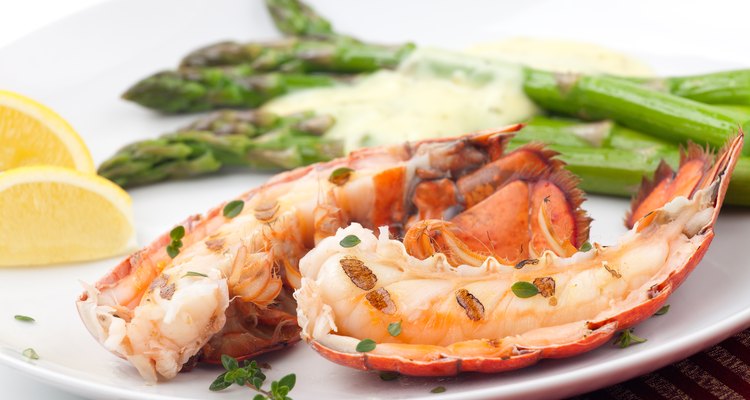
evgenyb/iStock/GettyImages
Choose a Method to Suit Your Meal
Premium ingredients are sometimes finicky and exacting in their preparation process, but lobster tails aren't one of those. Not only do they provide a – relatively – low-priced way to add lobster to your meal, they can be prepared in a number of ways: All you have to do is choose a method that's a good match for your kitchen, your skills or the meal you're preparing.
Choosing Your Tails
Most of the tails you'll find in stores come from one of the varieties of spiny lobster, which are common all over the world. They lack the eye-catching claws you see on the Atlantic lobster, so processing them for their tails alone – almost all of the edible portion – is an obvious choice. They can be harvested from either warm waters such as Florida and the Caribbean, or the colder waters off New Zealand, Australia and South Africa. Warm water lobster tails typically have yellow tones to their shells, while cold water lobsters lean more to dark browns and greens. Cold water lobsters tend to have better texture and flavor. The best cold weather product of all is Maine lobster tails, or their Canadian equivalent, though they're scarcer and costlier than most.
Cooking Methods and Times
You can cook lobster tails in most of the same ways as fresh lobster, though they'll be a bit quicker. It's always best to thaw them first, either by leaving them in the fridge overnight or in a bowl of cold water for an hour or so. Thawing gives you a tenderer lobster tail, though if you're pressed for time you can certainly cook them from frozen. The instructions here assume a thawed 2 to 3-ounce lobster tail. Cooking from frozen adds an extra few minutes to each method, while larger tails of 6 to 10 ounces can require 50 percent longer or more.
- Boiling: Make sure there's enough water in the pot to cover the tails to a depth of at least 1 to 2 inches, then bring it to a boil. Slide the tails into the water without splashing yourself, and wait for the water to return to boiling. Once it has, time 3 1/2 to 4 minutes and remove your tails from the water. Cut into one as soon as it's cool enough to handle, and make sure it's white all the way through. If it's still partly translucent, return them all to the pot for another minute of boiling.
- Steaming: Steaming is simpler than boiling, because you don't need to wait for the water to come back to a boil after you add the tails. It's also quicker, because you're not boiling as much water. Just put a steamer insert into a pot large enough for the tails, and bring it to a boil. Once it's steaming freely, put in your tails – taking care not to burn yourself with the hot steam – and steam for 8 to 10 minutes.
- Broiling or Baking Whole: This gives an especially showy appearance. Split the back of the tail's shell with kitchen shears, and gently crack it open with your hands. Wiggle a finger underneath the tail meat and carefully lift it up through the cracked shell, leaving it attached at the tail, so the meat rests restaurant-style on top of the shell. Brush with melted butter and broil for 7 to 10 minutes, or set into a pan with enough hot water to cover the bottom of the pan, and bake at 425F for 10 to 15 minutes.
- Broiling or Grilling Halved: With a sharp knife, split the tails down the middle. Loosen the meat from the shell at the sides, so you can season and baste down the sides with butter and spices. Grill face-down for 2 to 3 minutes until the flesh is well marked by the grill, then flip shell side-down and cook for another 6 to 8 minutes on a cooler part of the grill. If you're broiling, broil face-up for 10 to 12 minutes.
A Few Further Tips
The shells lend the tails a dramatic appearance, but you certainly don't need to leave the shell on. You can remove the tail and slice it into thick medallions, or dice it, and cook it directly in a sauce or poach it in butter over moderate heat.
Lobster is cooked through as soon as its flesh is a pearly white all the way to the center, without any trace of translucent grey. Overcooking the tails will leave them tough and rubbery. If you experience that misfortune, dice the meat finely and use it as a garnish to another dish. It becomes more chew-able when it's cut up.
Lobster is highly perishable, and needs to be cooked on the day it's thawed.
Related Articles

Cooking Methods for Frozen Dungeness ...
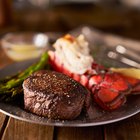
How to Prepare and Cook Frozen Lobsters

How to Cut Lobster Tails

How to Devein Tiger Prawns
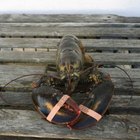
How to Boil Lobster at Home

Difference Between Boiled & Grilled ...

How to Clean Blue Crabs Before Cooking

How to Cook a Lobster on a Foreman Grill

How to Boil 1.5 Pounds of Lobster

How to Cook Fully Frozen, Whole Lobster ...
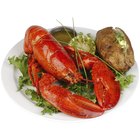
How to Thaw Lobster in the Microwave

How to Cook Langostino Tails

Step-by-Step to Cook a Frozen Lobster

How to Steam Lobster & Shrimp
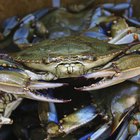
How to Cook Dead Crab

How to Cook Crab Claws
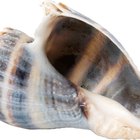
How to Remove Whelk Shells

How Long to Poach Bratwurst?
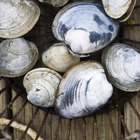
How to Steam a Quahog

When Is King Crab Season?
References
Writer Bio
Fred Decker is a trained chef and prolific freelance writer. In previous careers, he sold insurance and mutual funds, and was a longtime retailer. He was educated at Memorial University of Newfoundland and the Northern Alberta Institute of Technology. His articles have appeared on numerous home and garden sites including GoneOutdoors, TheNest and eHow.